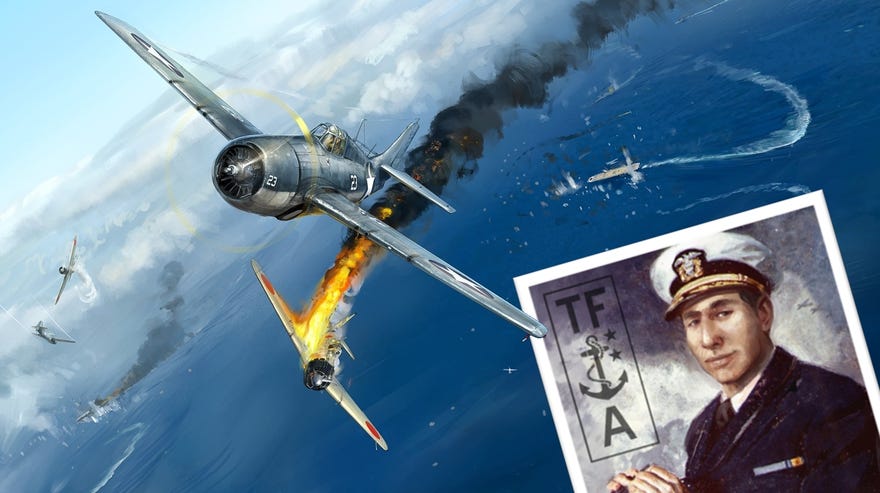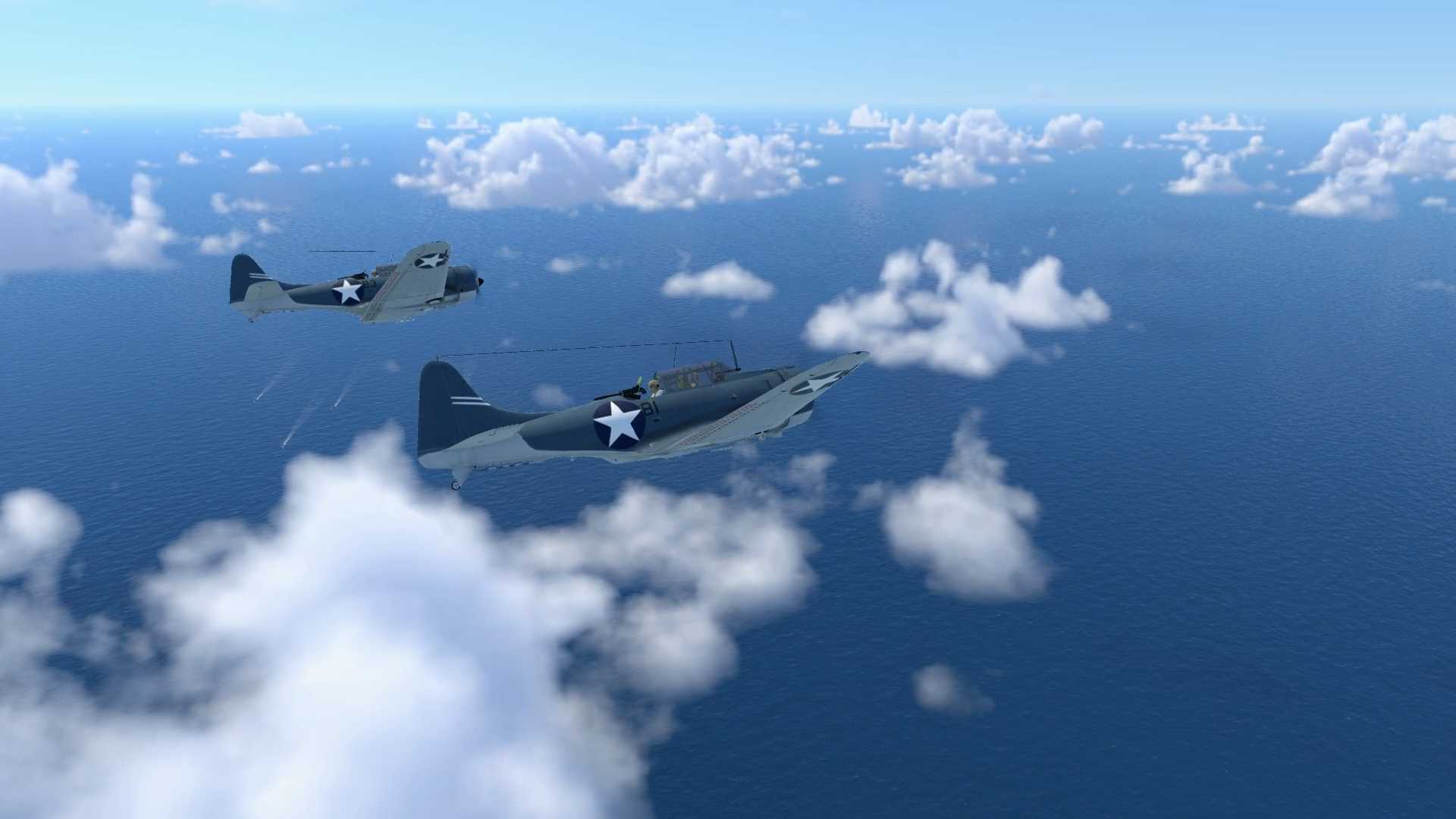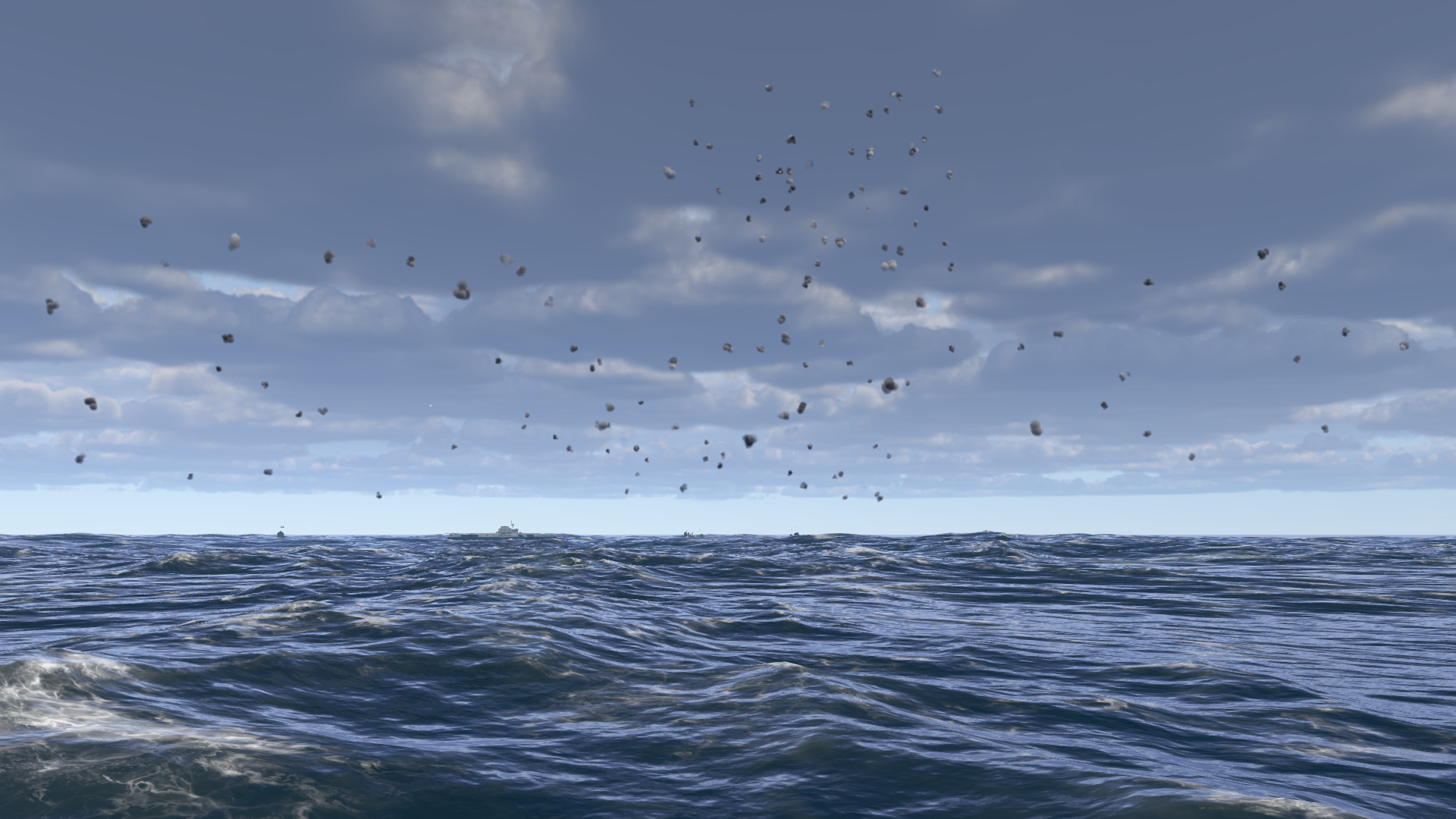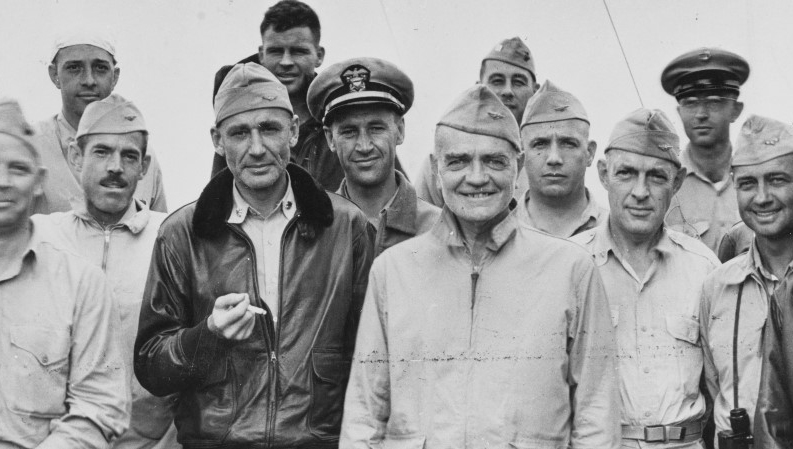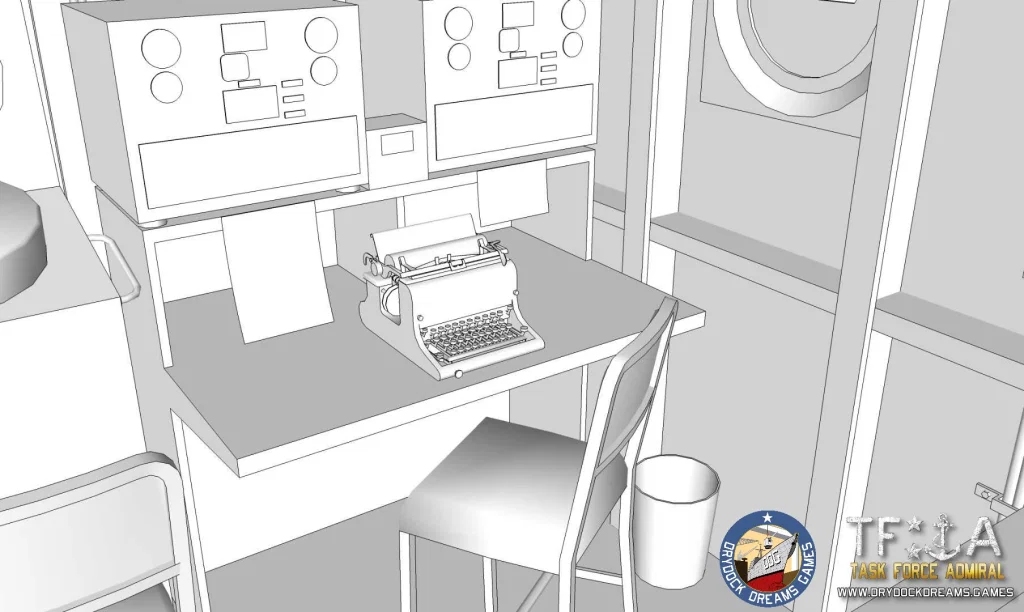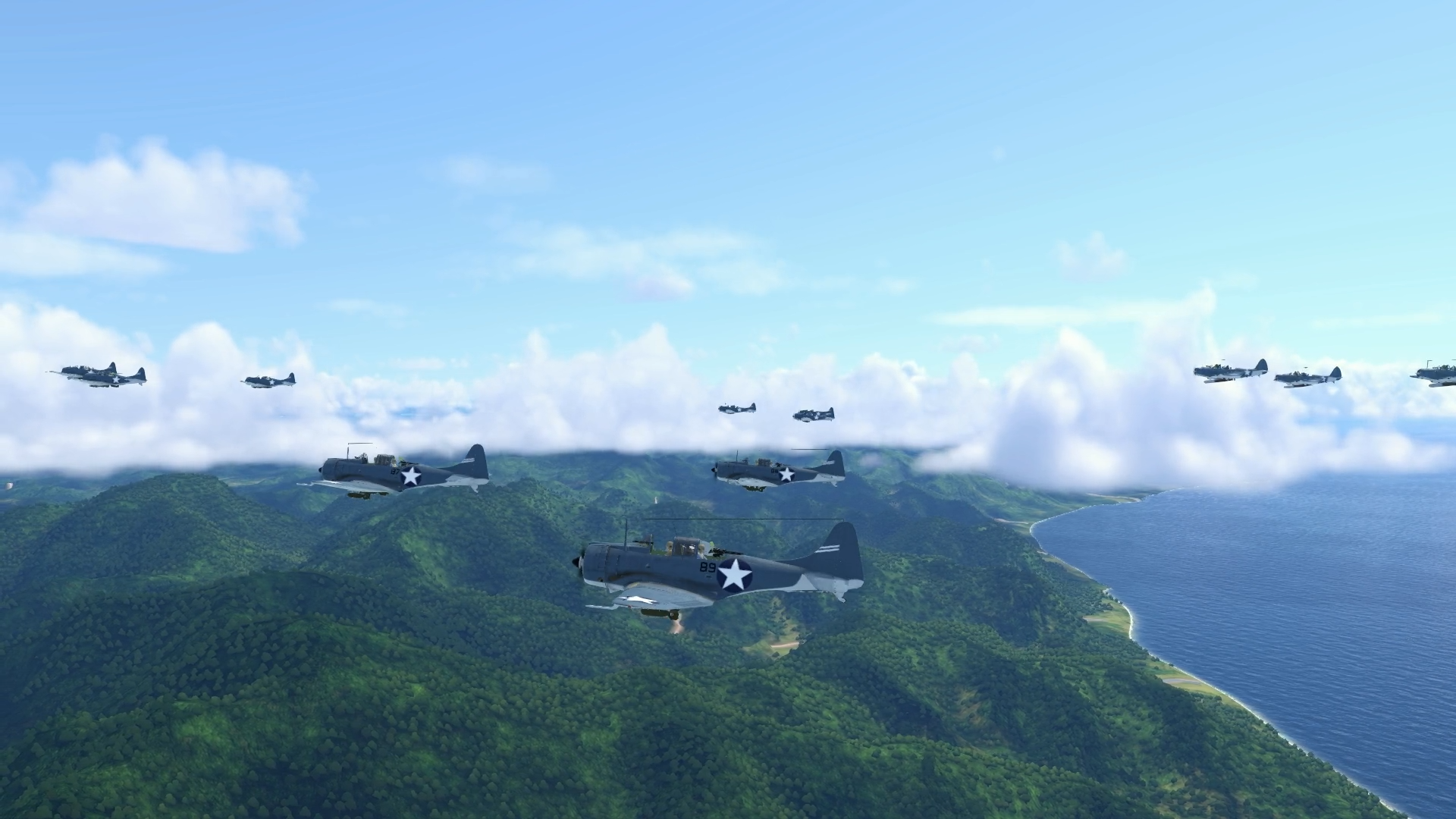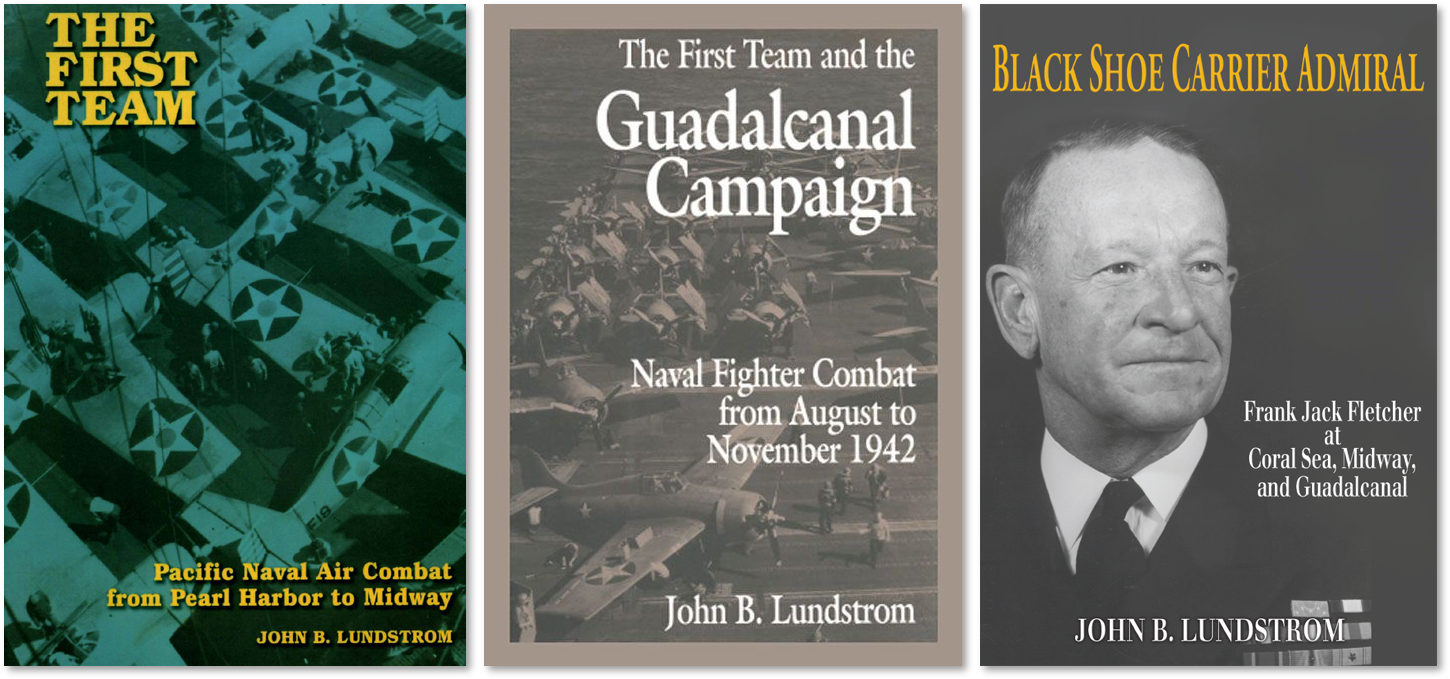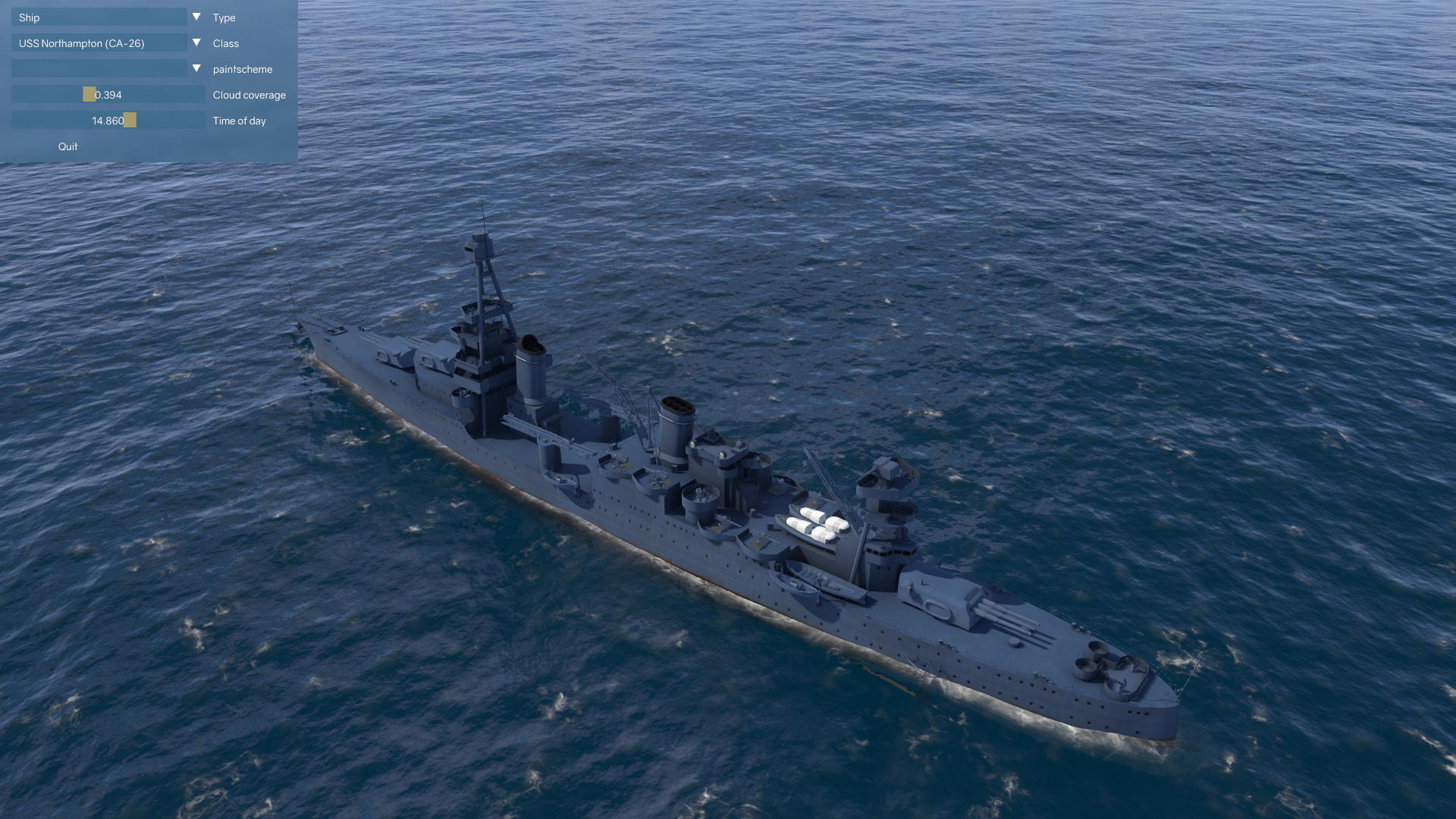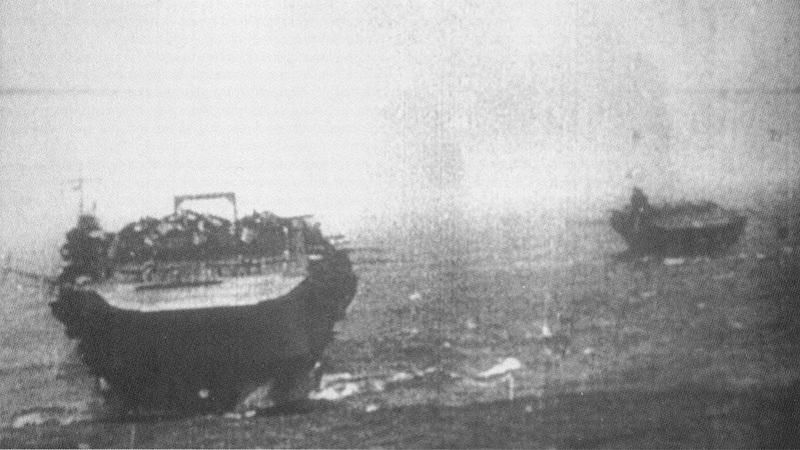The Flare Path talks Task Force Admiral
“Morale? Personally, I am not a fan.”
For a man patently hellbent on developing the most realistic Pacific Theatre of Operations wet wargame ever, French flat-top fan 'Amiral Crapaud' uses the 'R' word extremely sparingly. Still at least a year away*, Task Force Admiral Volume 1: American Carrier Battles is a project with ancient touchstones, but a thoroughly modern approach to graphics, physics, and what Carl von Clausewitz called “friction”. I've high hopes for Drydock Dream Games' debut diversion. Read the following Shinano-sized interview to understand why.
* A limited playable beta may arrive before 2021.
RPS: Was I wrong to describe Task Force Admiral as a "naval Combat Mission" when I first mentioned it in Flare Path?
Amiral Crapaud: Well, I wouldn’t say you were wrong – being compared to a landmark like Combat Mission is flattering enough for me not to dare contradicting you! Yet, in terms of basic mechanics, Task Force Admiral is only remotely related. CM is, of course, famed for its turn-based WEGO approach, while we are exclusively real-time. Still, I can think of two aspects which – in all humility of course – brings us close in terms of game-design.
First of all, Combat Mission’s WEGO architecture coupled with order delays recreates precisely the sort of command and control issues that are at the centre of our own gameplay. C3I woes should be a core feature of any game that wishes to put you in the boots of a commander in the field, or the shoes of an admiral at sea.
In the last decade, games such as Command Ops, Flashpoint Campaigns, Radio Commander, and Decisive Campaigns: Barbarossa have all, in their own refreshing ways, tried to capture the ever-present uncertainty and randomness that commanding officers have to deal with. For them - and future titles such as Burden of Command - it's no longer good enough to rely wholly on crude morale states... units rallying or breaking when a variable reaches a certain threshold. It's the sum of previously disregarded side factors that makes the experience of command really shine. As such, it is my feeling that the “chaos” introduced by Combat Mission’s WEGO structure was an important stepping stone in the evolution of computer wargaming – much like Close Combat’s ground-breaking mechanics a few years earlier. These games were not just trying to emulate tabletop rules and limitations, they used computer power and fresh ideas to evolve the genre and provide novelty. And yes, we intend to follow in their footsteps by innovating in our own way.
The other aspect that I find reminiscent is the way the series has been developed. Combat Mission was conceived as a multi-volume anthology. The engine that simmed Normandy was versatile enough to ultimately tackle the fighting in North Africa, Italy and the Soviet Union. At our own level, we harbour the same ambition of providing the genre with an engine that will be powerful enough to become and remain a standard for years to come. In addition to the usual perks of re-using a solid and well-known core of code, in our case the simulation-based nature of the engine gives us complete freedom of action when it comes to choosing a direction for our future plans.
RPS: Volume I will cover a relatively short time period - December 1941 to January 1943. In terms of tech and tactics, will early engagements have a noticeably different feel to late ones?
Amiral Crapaud: Technology and tactics evolved fast – fast enough to influence your approach, but not so fast as to radically change your priorities and preoccupations. Carrier combat remained a very experimental art throughout 1942. Most of the tech and tools in use by late 1942 were already available back in December 1941, they just weren’t as widespread or as efficiently operated as they were a year later. Air search radars, fighter direction, IFF, navigation beacons (such as the Z/B system), en-route sea refuelling, rapid-fire medium anti-air artillery, advanced damage control, signal interception and code breaking… The continuity is best reflected by the absence, apart from the TBF, of new types of carrier aircraft during this crucial year. Wildcats, Dauntlesses, Zeroes, Vals & Kates shouldered the burden of carrier duels from day one into the last moments of the battle for Guadalcanal.
In terms of tactics and procedures, yes, certain innovations – Jimmy Thach’s famed beam manoeuvre, for example – did alter things, but in most areas shifts were slight. American carrier strike coordination, for instance, was still something of a mess in October. In that regard, change only really happened in the course of 1943, when lessons from a year prior were duly learned and digested, allowing the US Navy carrier arm to evolve into the fearsome, decisive force projection tool it ultimately became.
Still, some changes will be more noticeable than others and might impact profoundly the course of battle. By August 1942, Shokaku had been fitted with a Type 21 air search radar, giving her in theory the same kind of early warning capability the American carriers enjoyed early on. By October, all American South Pacific major units were fitted with Bofors batteries in-lieu of their quad 1.1 inch “Chicago Pianos”, morphing the airspace over a carrier task force from a mild inferno to an indescribable hell for any Japanese pilot bold enough to try his luck.
In order to further explore the impact of historical changes in tactics and technology, we will provide some what-if scenarios plus the tools necessary to make more. Exploring a Midway standoff in August with radar-fitted IJN carriers and defective US intel, trying to imagine what kind of refit Carrier Division 1 & 2 could have received had the ghosts of Midway survived into the Fall, or examining the impact of embarked reliable Judy bomber squadrons at the time of Santa Cruz… all these scenarios (one third of the expected total offering of 30+) will add extra spice and challenge.
RPS: The game's lack of a campaign may prompt criticism. Are you ready for that?
Amiral Crapaud: This is merely one of our limitations, and may not necessarily prove to be the most criticised one. Playing the US Navy only, playing in 1942 only, no multiplayer… All of these things might fuel disappointment, especially after such a long period without carrier games.
Opting for a tight focus wasn't an easy choice, but it's a necessary evil. We are a very small team with a single guy doing all the programming, and a good but finite budget, so we had to give ourselves clear, realistic objectives. At the end of the day, I would rather have people not happy about our ambition but playing a good, complete and enjoyable game than the opposite. We are already on our way to simulating carrier combat at a scale and with an amount of detail never before seen, and surface combat to a standard at the very least equal to that of Fighting Steel. We're aiming to deliver an innovative combat narration system that brings historical battles and the men who fought them to life, 30+ scenarios, a replay function and a full scenario editor… It might sound disappointingly pragmatic, but bear with us, and the wait should be worthwhile.
RPS: How sophisticated are your flooding and fire propagation models? Will they interact?
Amiral Crapaud: Carriers could be delicate things. A single well-placed bomb had the potential to disable or doom one. Akagi was only hit by one bomb and that was enough to turn her into an uncontrollable inferno. Wasp was engulfed in flames fuelled by avgas after being on the receiving end of the deadliest torpedo spread of the war. Lexington was all but saved, until gas fumes ignited and disaster struck.
On the other hand, Yorktown and Hornet showed impressive resilience. The latter was hit by three bombs, three torpedoes and two suicide planes at Santa Cruz before calling it quits. When 369 127mm shells and numerous torpedoes failed to scuttle her, the Japanese took over, four Long Lances eventually delivering the coup de grâce. As the official report puts it “Hornet’s resistance to damage, as well as Yorktown's, exceeded reasonable expectations.”
Such wildly different fates can be explained by several factors. Damage control, for one. Drachinifel made a video explaining this at length just a few days ago. We will model this by allowing scenario designers to assign a variable level of damage control efficiency to ships in the editor. It will reflect national factors, but also the increasing proficiency of US Navy damage control as months went by. Damage control parties will work according to doctrine on the most crippling damage (particularly boilers, generators and uncontained flooding), although their action might be hampered by further damage. A bomb exploding in the vicinity of a repair party station or hitting the water sprinkling and curtain system at the beginning of the engagement might very well turn an otherwise controllable situation into a cascading ship-wide catastrophe.
Naturally, the other main factor is how the ships are built. Although some abstraction is needed in this area (especially in regard to module damage) we hope to avoid hit points as much as possible. Ships losing their center of gravity will end up capsizing, but a ship burning to its very guts will still float as long as its hull integrity is not compromised (If this happens to one of your vessels, don’t expect the blackened hulk to magically disappear beneath the waves. You will have to issue a scuttle order). We want damage to feel real, and be conveyed to the commanding officer in a natural way too. Anyone who thinks officers of the time had any way of telling when hull integrity or structural damage had reached 50%, must be mistaking CV-6 for NCC-1701!
Flooding, as shown on our prototypes, is already completely dynamic. Physics permitting, brine explores any hole it happens upons, and rushes to occupy any void. Watertight bulkheads are simulated according to original blueprints. Free surface effect will be present and correct and expose your inner compartments to added danger, sometimes prompting counterflooding. Fire damage will spread too. The worse flooding might do to a module is make it inoperative, but fire is never good news close to fuel or live ammo, and there is a lot of both aboard a carrier! More generally speaking, expect Midway-like events to have Midway-like consequences.
Finally, about water and fire interacting, we still have to decide if recreating the woes of USS Franklin is actually viable. Imagine your flagship listing due to an excess of firefighting water received from an escort. If we manage it, it would be another first!
RPS: How significant are 'soft' human factors such as morale, fatigue, and leadership in TFA battles?
Amiral Crapaud: We have not made a decision yet on how to implement the readiness and the proficiency of our pixel pilots. We hope to find a satisfying, intuitive mechanic for fatigue that will make you feel in command of humans rather than spreadsheets. On a real carrier, pilots don’t get to tell the skipper that they're tired or only a few points away from being “certified” fresh again! Carrier battles were often around-the-clock affairs lasting several days. They exhausted everybody with periods of constant readiness at battle stations, stressful waits, and bursts of adrenaline. Add to this the emotional impact of losing comrades in arms in droves and in the most sudden, shocking ways. If fatigue is properly implemented, ideally it will not only affect the aircrews. Ships' companies will also suffer from being on a war footing for too long.
Morale on the other hand, well… personally, I am not a fan. In my opinion, it wasn't really a factor. PTO 1942 is filled with examples, on both sides, where naval aviation crews performed well beyond what was expected of them in the direst of situations. Suicide attacks by damaged planes were not uncommon, as a successful plane strike could very well take a deck out of the war. There were acts of self-sacrifice aplenty, especially when planes were deemed too damaged to return home.
In the latest Midway movie (which I haven’t seen yet, but know the Bruno Gaido story appears in) this is precisely what happened when a damaged G3M Nell turned back and tried to ram Enterprise. This is also – possibly – what motivated a burning B-26 from Midway to aim for the bridge of Akagi. Hornet herself was hit not once, but twice by suicide planes at Santa Cruz. How should “morale” be represented when some aircrew, long before the Kamikaze phenomenon, made decisions like these?
Masatake Okumiya, who was aboard Junyo at Santa Cruz, describes the reaction of a young Lt. Kato, highest ranking survivor among the Kanbaku (dive bombers) pilots launched against Hornet and Enterprise that day. When he learned that he was to fly again against the same target that had decimated so many of his comrades “He was so shaken that at times he could not speak coherently”. Still, after talking to another pilot, he simply replied “I will go”, took off again in his plane and headed for the target all the same – and survived. The abundant literature we have shows plenty of examples of pilots fighting to be allowed to take off again, despite injuries or their superiors’ orders. I do not say that these people never experienced fear, or were not human. But I’d venture the guess that the training regime of naval aviation ensured that people who couldn’t take it wouldn’t be taking off from these flight decks in the first place. Actually, most of the morale breakdowns described in history books affected admirals rather than airmen and were caused by weight of responsibility not fear for personal safety. The Pacific – and carrier aviation in particular – claimed a number of careers, as flag officers were relieved for showing signs of physical and psychological exhaustion, defeatism or sheer incompetence.
I'm not convinced that other possible morale factors like living conditions and dreadful battle odds are all that relevant to TFA either. Yorktown’s crew had to survive on canned food at one point. The last steak on board was auctioned off, morale was low, there was no action. But does that mean they would have performed any worse had they come across an enemy force at that moment? I think not.
Damaged Enterprise was the sole operational fleet carrier in the Pacific after Santa Cruz. At a time of discouraging results and grim prospects for the USN she faced the Japanese threat almost alone. Did this affect the performance of her aircrews in any way? Absolutely not. It is seen perhaps as her finest hour, and rightly so.
RPS: Will fatigue, swell, and low light levels decrease the chance of successful carrier landings?
Amiral Crapaud: Yes. Sudden disorientation during a night launch for a dawn strike, a rogue wave raising the stern just when the plane was about to make contact, or a bouncy landing ending in the plane park (the kind that cost Don Lovelace, XO to Jimmy Thach, his life a few days before Midway) you can expect to see things like this in our simulation.
Besides the environmental hazards, there will also be mechanical gremlins to contend with. Enterprise lost four precious SBDs to engine defects before the sorties began at Midway (The problems may have resulted from the planes being readied too early). Radios malfunctioned regularly. Jammed guns were a common F4F ailment, so common in fact, some deck hands would carefully feed machinegun belts one bullet at a time in front of the pilots to put them at ease. Electronic gizmos were big and fragile in 1942, and prone to sudden failure. Tough luck to anyone who has to find his way back to his carrier in fading light with a defective homing beacon.
Mishaps like these can be randomly generated or scripted to occur at particular times in order to recreate specific historical situations. It's up to the scenario author.
RPS: How mobile is TFA's camera?
Amiral Crapaud: Our camera will be fully mobile and flexible. It will allow all the angles you'd expect in a wargame or flight simulation. At the lower realism settings, you will be able to roam freely around the battlefield by jumping between units or clicking a point on the map. The map itself is fully integrated in the 3D world.
If you choose to go for the highest level of realism, there will be restrictions. You'll be limited to a first person point of view in the flag plot and on the platforms of your flagship – a flag officer, after all, isn't omniscient. Witnessing a sortie launch or an attack on your ship in this mode is pretty special, and, thanks to after-action replays, you can always catch distant dramas later.
RPS: How are you intending to handle difficulty?
Amiral Crapaud: We will try our best to uphold your compact. I want to be able to keep the experience enjoyable to everybody, whether you are a grognard, an Il-2 player, a Eugen RTS fan or a World of Warships enthusiast. At heart TFA will be a hardcore wargame, but players will be able customise the experience in various ways.
Scouting mechanics are a good example. Have you never found it odd that in every game, including the supposedly hardcore ones, you always seem to be able to see what your scouting planes see? Know where they are? With no delay? Well, yes, Carriers at War, Task Force and Pacific Air War would give you an inexact composition of the enemy force – but is that all there is to naval search, some basic fog of war?
Let’s put ourselves in the shoes of your future virtual admiral-self for a minute. A search pattern has been defined, planes are leaving the flight deck, now what? Well. They disappear over the horizon, then from the radar scope, and there you go. Do you know what they see? No. Do you know where they are? No. Do you even know what happened to them? No! It’s 1942, you might be a few hours from a carrier battle: radio silence is paramount. You will not emit, in order to remain hidden to radio intercept – and your planes will not emit either for the same reason. There you remain, waiting (and accelerating time in-game if you really have nothing else to do – but you will, worry not!) and expecting a message that might very well never come.
Suddenly, there’s a signal. Your scout identifies itself. Good, at least you have a bearing on him. What else? Ah, he gives a position relative to the ship (that’s usually how it works, but sometimes a bullseye could be used). That’s how many nautical miles, on a given bearing. Ok. But before that, he had to estimate his own position over a featureless ocean, and from this approximation the position of a force that might be fifteen or even twenty nautical miles away from him. Naturally, he calculated all this from the original point of launch – which is already dozens of miles behind you by that time. We won’t ask you to make the calculations, but can you absolutely trust the position of that contact marker which just popped up on the map?
How many ships? How fast are they? What is their heading? Was the sighting made at short range, or does the spotter have to get closer to be sure? And is that report even reliable? At Coral Sea, the strike which was lucky enough to claim Shoho was launched on faulty information due to a code error that had placed carriers in a spot where there were, in fact, none. But nobody knew that until the scout came back onboard and candidly answered “What carriers?” when asked about his report.
Back to the action. Now your SBD has turned silent. Is he shadowing the enemy force, as instructed in the pre-flight instructions? Has he been shot down? Well, how would you ever know – it is not like the enemy Combat Air Patrol is going to send you a telex and flowers whenever they down one of your daring snoopers. Should you feed the information to the strike that is warming up on the flight deck and launch? Will you risk a silly wild goose chase, like the ones the Shokaku and Zuikaku fliers participated in at Coral Sea and Eastern Solomons? At their maximum range, an error of a few miles in the wrong direction might be the difference between success and a one-way trip for a TBD strike or a F4F escort, both types being known for their short legs. If you are in doubt, you are welcome to raise him on the radio – but is potentially betraying your position worth the risk? You might want to close the distance to improve the odds for your pilots, but what if the wind doesn’t blow in the right direction, forcing you to increase the distance instead to launch your strike planes into the wind, like at Midway? Oh, wait, what is this fleeting radar contact we just had now – does it mean an enemy Jake is about to eyeball us, or is it one of our scouts coming back early unannounced because of engine troubles? Decision time, I am afraid.
The experience I have just described is what I would call “the basic game”. Depending on your personal expectations and gaming background, you may wish to alter it. Keep it as it is, accept the challenge, and you might never know what really happened before you head to the after-action replay mode and become your own Samuel Eliot Morison. Deactivate, say, “friendly fog of war”, and you will be updated about the position of your plane in real time, like in every other game. Deactivate “inaccurate reports” and you will have a clear picture the moment the scout comes in visual range. Deactivate “realistic IFF” and you will know immediately who is a friend and who is a foe. Deactivate “limited comms”, and you can order your scout to head for the enemy target simply by clicking on it!
I guess you get the picture. You want to play TFA like a casual RTS? Fine. You want to make it feel as close to Carriers at War as possible? Please do! You want to challenge yourself with the uncanny stress of boxing in the dark? Our pleasure!
RPS: Is there a single Japanese AI or will all IJN admirals behave differently?
Amiral Crapaud: We plan on making a few strategic and tactical AI “profiles” for the scenario designer to choose from – a concept Ultimate General: Gettysburg explored before us with its distinct “personalities”. Aggressiveness and force conservation seem to be two central concepts that were interpreted very differently depending on who you were talking to. On the Japanese side, the recurring comparison between the cautious Nagumo and the tigerish Yamaguchi at Midway is a well-known trope, but temperament and character strength were a central factor in other battles too – including on the American side. In my dreams (and our programmer is very good at making them happen), the ability to customise a commander profile for each tactical unit (aka Task Group, or even Division) would certainly result in some interesting variety and unpredictability. Some admirals might retire after a certain loss ratio. Others will persevere and hunt you down. This loss ratio is also dependent on the incomplete information your opponent has about your forces, and will be affected by how close the AI is to achieving its operational objectives (which usually includes kicking your carriers in the nuts). An operation might be called off entirely by the strategic AI even though the tactical AI is still "up for it". Behaviours like this should guarantee high replayability.
RPS: Changing tack, can Drydock Dreams Games trace its origins back to a particular conversation or meeting?
Amiral Crapaud: Well, there was that day in Lyon. I had come to France on a business trip (I actually work in Asia) and the man who was going to become our developer, Jean-Baptiste, agreed to meet me out there. We had a walk, a talk, a good meal. Seeds were planted. I had actually found Jean-Baptiste within the Check-six.fr community, which used to be sort of my internet home 20 years ago. I reached him through his forum profile. Check-six is also the place where we found our 2D artist, Julien, a fine lad who happens to be an aviation art superstar in his own right and – luckily for us – was enthusiastic about the project.
The three of met in person for the first time over an afternoon pastis in Marseille just a few months ago. DDG is the kind of studio where everybody works from home, with JB and Julien in France, Rizki (our young yet super-talented 3D artist) in Indonesia, and Yours Truly in Eastern Asia most of the time. Naturally, it is hard to imagine that this sort of long-distance collaboration happening ten years ago, but this is the age we are living in and we are making the most of what it offers.
RPS: Are Flare Path readers likely to have encountered the work of DDG staff members previously?
Amiral Crapaud: Quite possibly. Jean-Baptiste's first game featured in this very column a few years ago. Remember BOMB? It was a fine, cute air combat game in the vein of Crimson Skies. Before and after that, Jean-Baptiste worked as Lead Dev and Producer on a number of other commercial projects, although these weren't typical Flare Path fare.
There's a good chance French-speaking aviation-partial FP readers will have seen Julien’s work in the past. His art regularly adorns the cover of French aviation monthly “Le Fana de l’Aviation”, quite an acknowledgement of his skill and his good taste in flying machines.
Come to think of it, mentioning Le Fana sends me off down a memory lane not unconnected to Task Force Admiral. I distinctly remember playing the Watchtower fighter missions of 1942: The Pacific Air War while avidly reading the corresponding issues of Le Fana my Dad had bought me when we attended the Paris Air Show. I was somewhere in my early teenage years. I was much into WW2 PTO back then already, and mildly frustrated by the lack of planes in Task Force 1942. Pacific Air War sort of quenched this thirst, but battling over the troubled yet empty waters of the Iron Bottom Sound, I ended up missing the furious surface warfare its older brother had brought to life. In those days, getting a fully multidimensional 3D naval wargame seemed very hard – and it still is 25 years later. I can track my passion for the genre and game-design to these happy days, I guess!
RPS: Did you experiment with off-the-shelf engines before going down the bespoke route?
Amiral Crapaud: BOMB for all its beauty - and shortcomings - was the reason why I approached Jean-Baptiste with this project in the first place. I knew he had made his own engine and it was the best tech demo I could hope for. It was obvious from the get-go that it offered all the technical features I needed to make my own dream come true.
After a little chat with him, I was convinced that there would be no better option on the table, and we never seriously considered anything else despite his own experience on other engines. The lad is in full control of what he does, and has all the needed experience to debug himself out of trouble when necessary. I rate this as the greatest advantage of using one’s own engine. When you come across a problem, you don’t need to submit a ticket online, or pray that the next build will somehow take care of the on-going issue. When we need a new function, he bakes it in all by himself and experiments can start in no time. This is one of the reasons why we have been able to post regular updates all this time. You can actually bend the engine around your game instead of bending your game around the engine, and this is an invaluable source of satisfaction, pride… and efficiency!
Another reason more closely related to the nature of our game is that Plankton is an engine conceived as a simulation-based toolbox. It is able to provide everything you might need for a flight or naval simulator, and much more. This was completely in line with my expectations for future development. If we manage to deliver this game properly and if it works well enough, we hope to develop “horizontal” expansions first (that is new theaters, new services, new timeframes…). Our plan is that Vol.2 will feature the Imperial Japanese Navy and extend on the timeline and combat areas. But should we choose to go “vertical” instead, nothing prevents us from adding new perspectives, whether it is at the micro-level (manning guns, flying a plane) or at a larger scale, with a strategic module for instance. The sheer freedom gained by recreating a full 3D world with simulation specs allows us to fine-tune the player’s experience to a level impossible with a third-party engine.
RPS: What's proved your most useful research resource?
Amiral Crapaud: Good old books have been our main resource from day 1, and as a true historical project, this game is largely built around them. Task Force Admiral wasn’t born yesterday from a sudden whim, so there was no need for me to build a reference library from scratch.
To those who think the collection pictured above is missing some key tomes, don’t worry, we have many more titles at our disposal in digital form. Although I am rather old-school and will privilege paper over bytes any day, because we work thousands of miles from each other and teleportation is still a few years away, I have had to embrace Epub.
John Lundstrom’s writings have been particularly important to the project. You could even go so far as saying they gave the game its identity. Before Black Shoe Carrier Admiral, in my mind Task Force Admiral was merely a real-time remake of Carriers at War. Now, one could say that it is closer to a game adaptation of that book.
When I started my shopping spree fifteen years ago, Lundstrom’s The First Team was one of my first purchases. The talent this man has for taking you back decades in time, for putting you on a carrier flight deck or in the cockpit of a Wildcat, is unequalled and riveting, and he entered my pantheon of great writers overnight. He released another magnum opus in 2005 with Black Shoe Carrier Admiral, a “battlefield bio” of Frank J. Fletcher, the rather obscure American commander at Coral Sea, Midway and Eastern Solomons who ended the war pretty much exiled in the Aleutians, far from any sort of fast carrier task force. Fletcher had fascinated me from the day I was introduced to PTO by my first volume of Buck Danny. Yet, despite his battle record, finding actual information about him was really hard. Lundstrom answered this need, and much more. A real eye-opener and myth-buster (not unlike Parshall & Tully’s Shattered Sword), this book provides an incredibly vivid insight into what carrier task force command must have felt like. I hope that our game will do it justice.
Besides the literature, the Internet has also been very helpful. We are grateful for the help of all those who have come to us with ship information, flight manuals, and 3D models on Facebook, Twitter and YouTube – and the great thing is that they keep coming! Military Aviation History, Justin Pyke, the Armoured Carriers blog, Military History Visualized and many others have all been very supportive and willing to share data and contacts. The friendship of other devs such as the great guys at Triassic and Jo Bader has been most valuable too. Thanks to this project I've met people I'd never have met otherwise, people like wargaming icon Philippe Thibaut who, coincidentally, also happens to be immersed in the PTO at present.
RPS: And what's the most surprising thing you've learned while researching the game?
Amiral Crapaud: The books we read are filled with startling trivia, so it is hard to pick one above the others. Here’s a neat one though. Did you know that a Yorktown-class carrier could steam astern at over twenty knots? This is the reason for the large number of arrestor cables one can see all over the length of the flight deck on interwar carriers. In case of battle damage on the stern, the idea was that planes could also be recovered over the bow! Now, will you be allowed to do that in Task Force Admiral? We are not there yet, but I sure hope so!
RPS: Are there any areas where, despite all the assistance, you're still having to best-guess because of a lack of available info? It's just possible an FP reader may be able to help.
Amiral Crapaud: There are still many grey, not to say grey-black areas, where we could use some help. Japanese planes’ actual performance, for one, is not an easy topic – as Il-2 fans know all too well. Any info besides that which is readily available on the internet, will always be greatly appreciated in order to fine-tune our flight models.
Finding good pictures of some of the historical personalities we depict in-game is another challenge. As an admiral, you will get to interact with your staff, and although many of these men had remarkable careers, it is sometimes really, really hard to source a good shot. The intelligence community is particularly affected by this problem (they seem to have been snapped far less often than pilots) and I will be very grateful if anybody out there – an owner of Steven Maffeo’s U.S. Navy Codebreakers, Linguists, and Intelligence Officers against Japan, 1910-1941: A Biographical Dictionary, perhaps - could help us find a good picture of Rear Admiral Ranson Fullinwider or Brigadier General Bankson Holcomb in their early years, among others!
Ah, and also, if someone could FINALLY tell us in clear and definite terms how a Japanese elevator actually works with a double hangar deck arrangement, and explain what the elevator cover on the above picture of Kaga was all about, we would really appreciate it!
RPS: Thank you for your time
* * *
